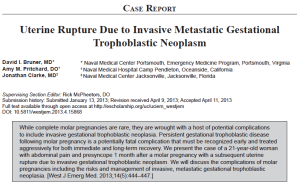A 14 year old girl is carried in by her parents after “passing out” at home. The parents report that she had an abortion 2 weeks ago after which she was transfused multiple units of blood. They report she has been complaining of increasing abdominal pain and fatigue over the past few days, but has otherwise been doing well since the procedure and going to school. They are especially worried because she has been diagnosed with a “uterine cancer” and has not started chemotherapy yet. On further chart review – you realize that she had a molar pregnancy and was subsequently found to have choriocarcinoma on pathology (and also clinical suspicion due to rising HCG levels and profuse post D and C bleeding).
You wonder to yourself – is this a complication of D and C? Of molar pregnancy / choriocarcinoma? What are the complications? (see below)
In the ED she is afebrile with stable initial vital signs, with an exam significant for mild pallor and a diffusely tender abdomen with guarding. After an IV bolus and labs are sent off the patient develops progressive hypotension dropping to 80’s over 40’s, although her pulse remains in the 80s. EKG is normal, as is an initial FAST exam. Labs are significant for an H/H of 9/30 (down from the last value of 11 two weeks prior).
What kind of shock is she in? Why isn’t she tachycardic (assuming 80 is her baseline pulse)?
Rapid fluid infusion is initiated, and when her BP remains low after 3 boluses, pressors are started. Due to progressive pallor and abdominal distension, pRBCs are ordered – and it’s a good thing they are, because a repeat shock panel yields a hemoglobin of 2.8! A repeat FAST shows fluid in the right and left upper quadrant. With titration of an epinephrine drip and pRBC infusion the patient’s blood pressure stabilizes in the 90’s over 50’s and she is stable to go to CT scan of the abdomen and pelvis with contrast, which reveals massive hemoperitoneum, a slit-like IVC, hyperattenuation of small bowels and adrenals all consistent with hypovolemic shock. The source of bleeding appears to be arterial in the left adnexa.
The appropriate work-up here includes consulting pediatric surgery, gyn-onc and IR. She is found to have a 1cm rupture of the left anterior uterine wall! Fortunately, our imaginary patient achieves hemostasis and stabilizes.
DISCUSSION:
COMPLICATIONS OF D AND C
-Uterine perforation – 0.3% premenopausal, 2.6% postmenopausal
-Most common immediate complication, usually during D and C (5.1%) while trying to control post-partum hemorrhage
-Cervical Injury – lacerations
-Infection: 5% have bacteremia, septicemia rare
-Adhesions: 90% of all adhesion are secondary to D and C
-Trophoblastic embolization (rare)
ABOUT CHORIOCARCINOMA
-A type of Gestational Trophoblastic Neoplasia (GTN) – others include placental site trophoblastic tumor, epithelioid trophoblastic tumor and invastive mole
-50% from molar pregnancies, 25% from miscarriages or tubal pregancies, and 25% from term or preterm
-Chorio seems to be most common after either molar or nonmolar pregancy
-Risk factors:
-Prior molar pregnancy (15-20% of complete hydatiform moles develop GTN, 1-5% of partial)
-Advanced maternal age (>40)
-Asian, American Indian or African Ancestry
-Highly malignant, aggressive epithelial tumor
-Metastasizes to lung, brain, liver, pelvis, vagina, spleen, intestine and kidneys
-Clinical presentation often due to bleeding from metastatic sites (also persistently elevated HCG levels > 100,000)
-Treatment
-Chemotherapy
-50% will require adjuvant surgery usually due to complications of metastases or to control complications of bleeding (e.g hysterectomy, pulmonary resection, uterine wedge resection, small bowel resection, uterine artery embolization)
-Prognosis = 95-100% overall cure rate, 87.5% with surgery
D and C FOR CHORIOCARCINOMA
-Limited role – surgery and D and C for cure are largely unsuccessful in inducing remission and carry a high risk of uterine perforation and bleeding.
-Uterine perforation itself is a complication of choriocarcinoma and can happen weeks to years later – here is a case report:
In conclusion, this patient was in hypovolemic hemorrhagic shock (cold shock). Her vital signs were interesting in that she did not display a significant tachycardia – one possible reason is a low resting heart rate, another is an increase in intra-abdominal pressure causing an increase in vagal tone and reflex relative bradycardia (the pathophysiology of which would be a whole other blog entry…)
References
1.www.uptodate.com. Initial management of low-risk gestational trophoblastic neoplasia.
- www.uptodate.com. Initial management of high-risk gestational trophoblastic neoplasia.
- www.uptodate.com. Gestational trophoblastic neoplasia: Pathology.
- www.uptodate.com. Gestational trophoblastic neoplasia: Epidemiology, clinical features,diagnosis, staging, and risk stratification.
- www.uptodate.com. Dilation and curettage.
- Osborne RJ, Fillaci VL,Mamel RS, et al. A phase II study to determine the reponse to second curettage as initial management of persistent “low-risk” non-metastatic gestational trophoblastic neoplasia: a Gynecologoc Oncology Group study. Presented at the 2014 Annual Meeting on Women’s Cancer. LBA 2
- Van Trommel NE, Massuger LF, Verheijen RH, Sweep FC, Thomas CM. The curative effect of a second curettage in persistent trophoblastic disease: a retrospective cohort survey. Gynecol Oncol. 2005 Oct;99(1):6-13.
- Schlaerth JB, Morrow CP, Rodriguez M. Diagnostic and therapeutic curettage in gestational trophoblastic disease. Am J Obstet Gynecol. 1990 Jun;162(6):1465-70; discussion 1470-1.
marmeg
Latest posts by marmeg (see all)
- Let’s pretend that an imaginary patient comes into your pediatric ED… - June 8, 2015
- Foreign Body Ingestions in Children, by Abi Iyanone - March 15, 2015
- Just another case of vomiting? By Dr Subramaniam - February 3, 2015
- Limping, continued… By Nishit Patel MD - December 29, 2014
- Approach to the Limping Child by Dr. Virteeka Sinha - November 12, 2014

